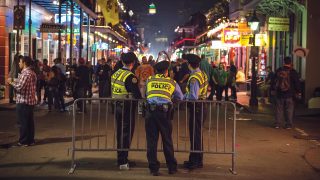
Recently, I was requested to write a plea to ask for help, to be delivered at the funeral of a police officer who died by suicide. My message was as follows: “Asking for help is hard. This is harder. In policing, it is a sign of strength and wisdom to recognize that an assist officer is needed to handle a call. Life is no different. We do not have to do it alone. There are people, many to your left and right, who would assist you through your hardest times. Please let them. Let’s also commit to caring for each other now and in future hardships. If you’re unsure who your assist would be, please connect with a peer team member or chaplain for guidance.”
The wake of sorrow from an officer suicide spreads wide. It pains those closest to the officer, peer supporters who felt a responsibility to prevent suicide, peers, family and friends who wonder what they missed.
Tragically, police have a 54% higher risk of dying by suicide than the general population.[1]Violanti, J.M., and Steege, A. (2021). Law enforcement worker suicide: An updated national assessment. Policing: An International Journal, 44(1), 18–31. For this reason, I want to highlight that the road to suicidality is divided between the “warm path” and the “hot path.” The warm path involves a slow erosion of well-being where signs of suffering become visible to others. The person can no longer hide their pain. The “hot path” involves someone suddenly feeling trapped in a situation (relational, legal, health) with an impulse to act.
First responders need tools for the crisis, but they also need daily practices that build a baseline of well-being.
The warm path
The warm path includes an incremental increase in thoughts of suicide with a slow decline in well-being. Suicide expert Dr. Olivia Johnson has identified the “10 Fatal Factors for Police Suicide.”[2]Johnson, O., and Krawczyn, J. (2021). Think like a detective: Is there a change in behavior? In O. Johnson, K. Papazoglou, J. Violanti, and J. Pascarello, (Eds.), Practical considerations for … Continue reading According to Johnson and Krawczyn, they are:
- Interpersonal relationship issues
- Substance abuse and addiction
- Cumulative stress and trauma
- Sleep disorders
- Mental health concerns
- Medical issues
- Firearms access
- Under investigation
- Pending/nearing retirement
- Other major life events/situation
While there’s no formula, the more factors present, the greater the risk for suicidality. The presence of these factors does not mean that suicide is imminent or eventual. Many first responders deal with these issues regularly. It’s these factors plus the absence of healthy coping mechanisms, a baseline of health and support systems that contribute to suicide risk.
“The best prediction of how you’ll be two years after a major disruption, whether as an individual or as an organization, is how you were doing two days before. Build on the basics.”[3]Gist, R., Taylor, V., Watson, P., and Leto, F. (2019). Understanding suicide and the fire service. A closer look at a complex problem. Firehouse, Health & Safety Report, September 2019, A16–A18.
The preceding quote reflects that a first responder’s baseline is a significant predictor of how they will navigate the crises listed as “fatal factors.” This informs my approach to addressing suicide in police, which is to teach healthy coping mechanisms and healthy living. First responders need tools for the crisis, but they also need to have daily practices that build a baseline of well-being. Proactive peer supporters can teach the following skills at academy and in-service trainings:
- Crisis tools: Breathwork for calming, grounding, mental reframing of crisis (self-talk that is affirmative or instructive), decision-making under pressure, hotlines, peer support and confidentiality laws relating to getting help
- Baseline wellness: Strengthening relationships, health, sleep hygiene, financial wellness, with programs related to these aspects of wellness

The hot path
The hot path refers to a crisis with an impulse to act, resulting in a lack of warning signs. Without signs, we feel helpless, and we’d rather feel guilty than helpless, so we blame ourselves anyway. Pairing an impulse to act with access to means and acquired capability (where chronic exposure to violent death systematically desensitizes first responders) can be a deadly combination. Sleep deprivation tends to be a contributing factor, as well. I’ve worked with first responders who have previously attempted suicide on impulse after days of poor sleep.
Dr. Craig Bryan, another expert in first responder and veteran suicide, challenges us to “rethink suicide.”[4]Bryan, C.J. (2021). Rethinking suicide: Why prevention works and how we can do better. New York, N.Y.: Oxford University Press. According to Bryan, our focus on mental health issues and, consequently, mental health awareness campaigns, is misguided. He cites research that demonstrates that mental illness labels are largely applied after a suicide and are not truly the causal factor. It’s confirmation bias when we assume the person must’ve had depression to have taken their life. It denies or, at least, minimizes other contributing factors that are amenable to change. Bryan cites research that 75% had no prior plan, 25% of those who survived their attempt stated that the time from decision to action was within five minutes and 70% attempted within an hour.[5]Hawton, K. (2007). Restricting access to methods of suicide. Crisis, 28(S1), 4–9.[6]Simon, T.R., Swann, A.C., Powell, K.E., Potter, L.B., Kresnow, M., and O’Carroll, P.W. (2001). Characteristics of impulsive suicide attempts and attempters. Suicide Life Threat Behavior, 32(supp), … Continue reading This phenomenon is referred to as “the golden hour.” So, impulsivity is a significant concern and cannot fully be addressed by standard mental health awareness campaigns where we’re taught what to look for. It’s a setup for feeling guilty for missing the signs. I have known of first responders who fit Bryan’s model. They were not suicidal until they were in a crisis and were compromised by sleep deprivation, and lacked adequate coping mechanisms.
Based on his research and experience, Bryan offers a compelling case for focusing on decision-making skills, coping and access to means as more direct measures to prevent suicide. I believe we also need to strengthen support systems and increase awareness of crisis services while addressing the fear of using them (fear of losing job, being judged, not being helpful, etc.). Bryan’s model is compatible with Johnson’s. I can see a “both–and” explanation that casts the net wider to capture the entire picture, including planned and impulsive suicides.
In summary, since asking for help is hard, peer teams and agencies can place evidence-based information and programs within reach of every agency employee well before they need them. Provide it to them early and often, because they deserve it.
As seen in the September 2025 issue of American Police Beat magazine.
Don’t miss out on another issue today! Click below:
References
| 1 | Violanti, J.M., and Steege, A. (2021). Law enforcement worker suicide: An updated national assessment. Policing: An International Journal, 44(1), 18–31. |
|---|---|
| 2 | Johnson, O., and Krawczyn, J. (2021). Think like a detective: Is there a change in behavior? In O. Johnson, K. Papazoglou, J. Violanti, and J. Pascarello, (Eds.), Practical considerations for preventing police suicide (pp. 177–198). https://doi.org/10.1007/978-3-030-83974-1_10. |
| 3 | Gist, R., Taylor, V., Watson, P., and Leto, F. (2019). Understanding suicide and the fire service. A closer look at a complex problem. Firehouse, Health & Safety Report, September 2019, A16–A18. |
| 4 | Bryan, C.J. (2021). Rethinking suicide: Why prevention works and how we can do better. New York, N.Y.: Oxford University Press. |
| 5 | Hawton, K. (2007). Restricting access to methods of suicide. Crisis, 28(S1), 4–9. |
| 6 | Simon, T.R., Swann, A.C., Powell, K.E., Potter, L.B., Kresnow, M., and O’Carroll, P.W. (2001). Characteristics of impulsive suicide attempts and attempters. Suicide Life Threat Behavior, 32(supp), 49–59. |





